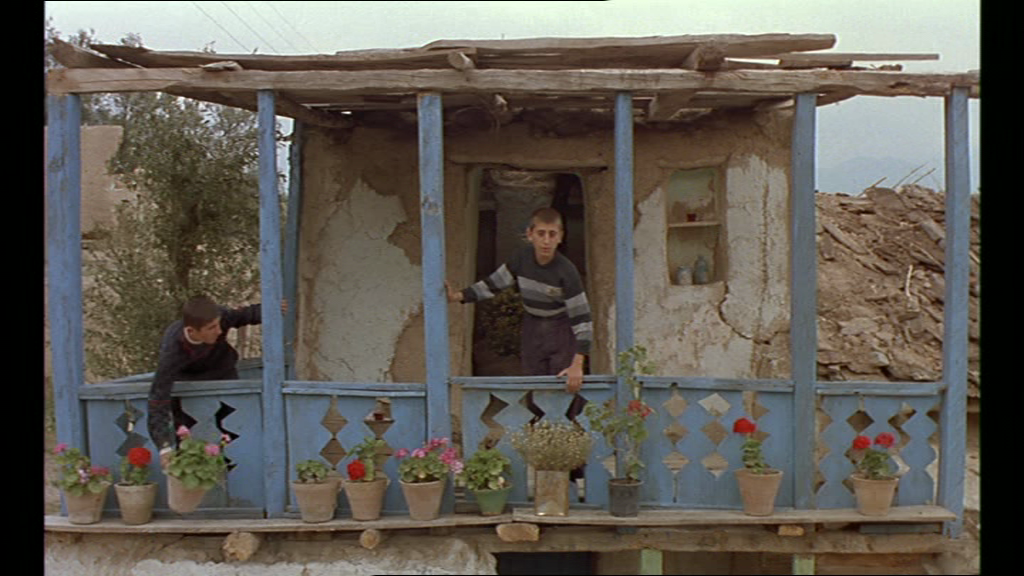An essay in two parts
1. Where the Truth Lies (or, The Flowers and the Trees)
Close-Up
The majority of the tributes to Abbas Kiarostami refer to the principle that is taken to be the most fundamental aspect of his art: the foundation of truth on a lie. A short piece by Mehrnaz Saeed-Vafa – author, with Jonathan Rosenbaum, of one of the few English-language books on Kiarostami – is typical in this regard. She singles out Close-Up (1990), calling it “a testament to Kiarostami’s belief that the shortest way to the truth is a lie.” It certainly is true that this celebrated docu-fiction about an unemployed, divorced printer with Turkish roots, Hossein Sabzian, who deceives a propertied Iranian middle-class family into taking him into their home by pretending to be famed filmmaker Mohsen Makhmalbaf, came at a crucial juncture in Kiarostami’s career. After two decades of making films, both shorts and features, under the wing of the filmmaking department at the Institute for Intellectual Development of Children and Young Adults (Kanun) in Tehran, an important hub for free artistic expression and dialogue he had helped set up, Kiarostami had gained international acclaim with Where is the Friend’s Home? (1987), a picaresque tale of education about a young boy determined to return his friend’s notebook in a neighboring village. This film is much of a kind with the understated, transparently poetic style of the Kanun films, starting with The Bread and Alley (1970), a simple style that nonetheless hides moral complexity and subtle social critique. In fact, you could say about all of Kiarostami’s films that they are ‘pedagogic,’ not in the sense that they are didactic but, in a more open manner, that they explore possibilities of facilitating learning. When Kiarostami came across the Sabzian incident in an article in an Iranian magazine, he was struck by its allegorical potential. Seeing an indirect way to explore the tension between contemporary image culture and traditional Islamic law, or more specifically, the function of cinema under an iconoclastic regime, he immediately decided to shoot a documentary on the subject.
Kiarostami had made a number of documentaries during the early ‘80s – in the years following the Islamic Revolution – that already expounded on truth and artifice and the constructedness of the film image. In the playfully reflective short Orderly or Disorderly (1981) – reflective not just of the properties of cinema but of the ‘orderly’ regime of Islamic authoritarianism – the titular variations on exiting a classroom, getting on the school bus or directing traffic are separated by clapboards and the filmmaker yelling ‘cut, ’as if the different variations on social behavior are also different ‘takes.’ First Graders (1984) is a feature-length fly-on-the-wall look at six-year old boys’ first day of school in one of Teheran’s poorest neighborhoods, in which the interrogations of naughty boys sent to the principal’s office are clearly staged and provide another commentary on the methods used to teach discipline. But it is only with Homework (1989), again a full-length documentary shot on 16mm, that a question took root referring not just to the artifice and ‘fictionality’ of any documentary, but to the equally unavoidable observer effect of changing the social dynamic of an environment by bringing a camera into it. Homework, consisting of a number of interviews with pupils of the Shahid Masumi primary school on the matter of home assignments, starts with the filmmakers commenting offscreen on the experimental nature of the project and ends on an unforgettable image of a an utterly terrified small boy pleading with the director to turn off the thing that frightens him. The children in this film are intimidated by the camera, are conscious of being recorded, but what makes them lie about liking homework better than watching cartoons is not iconophobia (the response to the camera of the Kurdish villagers in The Wind Will Carry Us [1999]) but the authoritarianism of their teachers, standing in for the authoritarianism of a strict theocratic regime, which in turn they see reflected in the demiurgic film director’s dark glasses. So amidst all the lies, including the exposed one of the documentarian’s feign of objective registration, there is truth. The truth is that an authoritarian regime prevents growth, but also that cinema, even as ‘mere’ observation, cannot but share in some of the mechanisms of power it denounces. Kiarostami’s ‘presence’ will be a crucial concern in the films to follow that stage the role of the man with the camera in a way that is not dissimilar from what Godard and Rouch were attempting with their ‘cinéma verité’ in the early sixties. It is only at the beginning of a new, more experimental period in his work with the films shot on digital video that Kiarostami will start to stage his absence rather than his presence.
Sabzian lies even more than the children in Homework, not out of self-defense or because he is intimidated by authority but because he aspires to an ideal self, to upward mobility by the unlikely path of becoming a filmmaker. He sees himself in Makhmalbaf’s The Cyclist (1987), a neorealist fable about an Afghan refugee who rides his bicycle in the town’s square for seven days and nights with the aim of raising money for the surgery for his dying wife, because the refugee character has decided to act, to change his lot and demand recognition for himself and his situation. Sabzian takes the idea of acting in its double sense, projecting himself as a character into a fiction in a similar bid for recognition and self-respect. The fact that as a result of his act he ended up in a Kiarostami film is poetically apt for a number of reasons. For one, Sabzian is the kind of Renoirian everyman that passes through movies, like the man with the two turkeys of whom the taxi driver asks directions in Close-Up. Asking directions is a favored dramaturgic device because, like the view through the car window, it makes it possible to include the people in the background. The man is, for all intents and purposes, a character, trying to haggle off the turkeys on the driver. The cabbie, to all appearances another bit player, actually has a crucial mirroring function in that he too longs for recognition and respect. In his case the longing is nostalgic and laced with bitterness: he used to be a pilot in the Iranian Air Force during the Imperial era and now has to resign himself to dreamily watching the skies. Regardless of social status, most of the characters in Close-Up – the duped family, the journalist, the arresting officers, even the judge – dream of their moment in the spotlight, of being recognized by the camera. (It is because they all want their fifteen minutes of fame that they agreed to appear in the film in the first place.) In a 1994 interview with Kiarostami for Jean-Pierre Limosin’s filmed portrait in André Labarthe and Janine Bazin’s wonderful Cinéastes de nôtre temps series (entitled ‘vérités et songes,’ truths and dreams), a hilarious moment occurs when the director is discussing the theme of Close-Up and ‘the power of the image’ while in the background passers-by are trying to get into the camera’s view: “They are all Sabzians”, Kiarostami ruefully concludes. But on the other hand, Sabzian’s aspiration is genuine in that he truly believes in the power of cinema to unbalance social stasis, to change lives. In the end, after Kiarostami has introduced Sabzian to the real Makhmalbaf and we have come to understand and empathize with this sad-eyed modern-day Myshkin (who quotes Tolstoy during his trial), he is proven right, having convinced both as a character in a fiction and as an authentic human being.
In the meantime, the lie of a cinema pretending to be straightforward documentary recording has been inflated to unseen proportions. The official version runs that Kiarostami was granted access to Sabzian’s trial, and that the filmed record of the trial was then edited together with interviews with the protagonists and re-enactments of the circumstances leading to the arrest, performed by all concerned. But even the trial – shot with a long lens for close-ups and a wide-angle lens for keeping an overview, as explained to Sabzian by Kiarostami who seems to be directing the proceedings as much as the judge – is, for all its surface realist effects (16mm grain, scratches, lens flare, unsteady framings, loss of focus), a re-enactment, announced by a clap, with cutaways to the judge edited into what is a staged hearing, a mock(-up) trial. Nothing in this film is ‘real,’ certainly not the feign of technical malfunction at the end, when the sound on Sabzian’s clip-on mic drops off as he is taken by Makhmalbaf on the motorcycle ride of his life, with the filmmakers in pursuit in a cheap minivan with a broken windshield.
A film about an impersonator in which everything is a lie, in which everyone lies and real people – including the filmmaker – impersonate themselves, a film that fools the audience like Sabzian shammed the Ahankhahs, seems like a textbook illustration of postmodernism, a baroque hall-of-mirrors or ‘mind-fuck’ movie that stands to be compared to Being John Malkovich or Adaptation. But is Kiarostami a postmodernist? Literary theorist Norman Holland certainly seems to think so. Writing for his blog A Sharper Focus, he calls Kiarostami a “postmodern documentarist” and Close-Up “a film that is both true and untrue.” If something is true and untrue at the same time, then logical contradiction occurs and the assumption that knowledge can be predicated on a fixed and ascertainable basis goes out the window. In other words, anything goes. More precisely, Kiarostami seems to treat cinema in terms familiar from Nietzsche’s philosophy of art and language: language relies on concepts (metaphors) that do not correspond to reality. What is considered to be truth is merely an illusion about which one has forgotten that this is what it is. What art does is reveal the truth about the illusion of truth. As a deception, art has a ‘good conscience’ in that it names the illusion as illusion. Film historian Gilberto Perez, in his magisterial book The Material Ghost, takes a different stance, less deconstructionist stance, however, by stressing the core of truth behind such surface play of deceptions. Perez cites the scene in which Kiarostami first interviews Sabzian, and the camera – locked out behind a barred window – starts zooming into the close-up from which the film derives its title. At the end of the interview Sabzian pleads with Kiarostami to convey a message to Makhmalbaf: “Tell him his last film is my life,” by which he means more than simply that the film reflects his life. It’s also significant that, in contradistinction to most of his image-hungry contemporaries, Sabzian does not model himself on a star or a media personality but on an artist, a filmmaker. (The fact that the Ahankhahs do not know what Makhmalbaf looks like, in itself, runs counter to the idea that Close-Up merely repeats the Frankfurt School commonplace that identifying with movie stars serves the status quo.) Even Sabzian’s love of cinema is not necessarily true, as the close-up is not necessarily truth, Perez writes. But he does not want us to discount it as necessarily a lie: “For Kiarostami, for the society in which he works, art counts, and counts not just as critique telling us to discount it. Art is a construction, and must be recognized as such, but that doesn’t mean that the only thing to be done about it is deconstruction.” Art can have the power to reflect a life, to change it even. Although maintaining that what Close-Up expresses above all is that “seeing truth is difficult, ultimately not even possible,” Holland – getting to Saeed-Vafa’s point – seems to agree that “this work of art presents a truth,” albeit in such a way “that it looks like a fake.” Let’s notice that Holland’s use of the term ‘fake’ also opens a connection to the fine arts, one that Kiarostami will explicitly explore in his next-to-last movie, Certified Copy (2010). Fittingly, for Perez the truth of the film is contained in a moment of beauty. When Makhmalbaf takes Sabzian on his motorbike, the idea of deconstruction achieved through the fooling around with the sound is completely pushed to the background by the introduction of an Ozu-like splash of bright color into an otherwise drab palette by the pot of flowers Sabzian picks up on his way to the Ahankhahs. The theme music from Kiarostami’s earlier The Traveller (1974, another film about a dreamer beloved by Sabzian) comes in, turning this semi-documentary moment into pure cinematic bliss. The beauty of the moment, for Perez, who thereby identifies Kiarostami’s film with a pre-modernist sense of the aesthetic, shows us “what art can do, what the experience of art can do for us, what art can make happen.”
Life, and Nothing More… and Through the Olive Trees
Similar moments of beauty, of flower pots, will occur throughout Kiarostami’s next two films, Life, and Nothing More… (1992) and Through the Olive Trees (1994). These films further subvert the distinction between fact and fiction and push further the inquiry into the constructed nature of cinema. But they also trade in the modernist epistemological reflection on the partiality of any (including the documentarian’s) claim to truth for a bigger wager on art’s potential to ‘unconceal’ essential truth. In Life…, Kiarostami’s last film for Kanun, the director of Where is the Friend’s Home? (played by Kiarostami’s friend, Farhad Kheradmand), accompanied by his young son Puya (played by the cinematographer’s son), goes looking for the two Ahmadpour boys who starred in that film after the region where it was shot, the Gilan Province in rural Northern Iran, was severely hit by an earthquake in 1990. As a result of the earthquake 6.000 people were killed in the Rudbar area alone and the fate of the Ahmadpour boys and other players in the film, villagers of Koker and Poshte, long remained uncertain. The film recreates a trip to Koker that Kiarostami and his son undertook immediately after the quake. Although certainly in the first half the film presents itself as straight reporting of the effects of the convulsion, the film is again built on lies, starting with the fact that the trip is a re-enactment of an earlier one and that Kheradmand, the man behind the wheel this time, couldn’t drive and therefore most of the shots in which we see him drive had to be faked or taken from a great distance. But the biggest lie is that a film that began shooting five months after the earthquake hit can never be taken to be (even partly) a documentary about the immediate aftermath of the catastrophe. While the landscape is still visibly scarred, by the time principal photography started with the actors the highway to Roudbar would have been cleared, resettlement of the village populations would have begun and the tent villages would have largely disappeared. In Through the Olive Trees, a film that supposedly takes place during the shooting of Life…, it is actually said – by the two actors playing the role of the director – that all the villagers of Poshte have left and have resettled along the Roudbar highway. There would have been no more helicopters circling the area, helicopters that in the film we constantly hear but do not see. In the shots of the highway we see through the driver’s window during the first minutes of the film, there is no sign of emergency vehicles, although we hear the sirens of passing ambulances. When Puya asks about the transmission posts in the area we get a shot that does not seem to fit any point of view which then pans back to look through the windshield (as in Close-Up) revealing a road that is strangely empty, whereas in the previous shots cars were seen in all three lanes. Clearly, this car trip and its confusing and erratic geography is a construction, a composite of raw and staged material shot at different times. Kiarostami confesses in a typical interview of the time:
I shot one part five months after and the rest eleven months later. It was all a reconstruction, although it looked like a documentary – the story starts five days after it – to put events at a certain distance.
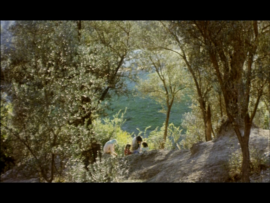
The reason we put something at a distance is because we are too close to it to see it properly. This does not mean that we thereby put it ‘in perspective,’ that we relativize it. It doesn’t even necessarily imply that we want to see it more objectively. What Kiarostami means, I think, is that he put events at a certain distance to discover their truth, defamiliarized them in order to see them for what they really are. We can actually pinpoint the moment when the film pivots from what appear to be documentary or even meta-documentary concerns to a more philosophical inquiry into essence and appearance: from the terraced mountain road leading to Koker the director spies in the valley below what looks like a graveyard, a Valley of the Dead where an ambulance of the Red Crescent can be seen taking off. On the soundtrack we hear chanting, a lament, a stately wail. The music, the first in the film, bleeds over into Vivaldi’s Concert for Two Horns as the director observes, through the foliage creating a foreground proscenium for a picture, what can only be described as a pastoral scene with two women and their children mending clothes in the sunshine while the Crescent ambulance silently glides by in the background.
The moment creates an opening in the film in which ‘truth’ shines through, after which the emphasis shifts back to a Close-Up-like reflection on the relation between (surface) truth and fabulation. The next view is of a man running up a hill via the same zigzag path that brought Ahmed to the neighboring village in Where is the Friend’s Home?, restoring us to the pastoral world of that film, to a time before the quake. A short while later the director and son pass a man who is carrying a toilet bowl on his back up a steep climb. He is given a ride and we discover that he is Mr. Rouhi, who played the old carpenter in Friend’s Home. (In Through the Olive Trees, it is the man who played the teacher in Friend’s Home who is given a lift and, like Mr. Rouhi here, is mostly heard rather than seen, as if to allow the viewer to bring back the memory of the character from the film.) The ‘real’ Mr. Rouhi definitely has much more modern views than his character in the film, who bemoaned the arrival of iron doors in his village, a threat to his trade. Here he sings the praises of the toilet bowl: “Those who are dead are dead; but the living still need this precious stone.” Later he qualifies such stoicism by summarizing the philosophy of Persian poet Omar Khayyám: “No one can appreciate life who has not seen death.” Khayyám, a reference in this film and throughout Kiarostami’s filmography, practiced an epicurean humanism that is shared by the director of Life, and Nothing More… and is usually propagated by sage-like characters like the Azeri taxidermist in Taste of Cherry (1997) and the country doctor in The Wind Will Carry Us, the latter explicitly citing Khayyám’s Rubaiyat. The philosophy behind Khayyám’s sufi poetry is the reason for the lie, for introducing beauty where at first glance there is only death and decay.
Puya understands about stoicism and contingency, that not everything in life is preordained, but he doesn’t seem to grasp the premise that cinema is not always truth: “Mr. Rouhi, why where you much older and hunchbacked in the film?” Rouhi explains that this was what the filmmakers wanted him to look like and muses, “What is this art that makes people look uglier and older than they are? The art is in making people look younger, more beautiful.” When they finally reach Rouhi’s home, the director expresses mock surprise at seeing him in this house, strikingly painted baby-blue, where “one would expect to see you in the house of the film.” “That wasn’t my real house,” Rouhi explains, more to us than to the director. Then, offhand and offscreen: “To tell you the truth, this isn’t my real house either! My real house was destroyed and I live in a tent.” We later learn that the house actually belongs to a certain Ali Gholami, who died in the quake, but even Mr. Rouhi’s claim that he lives in a tent, at this point, is no longer certain. What Kiarostami has done with Rouhi’s adobe house corresponds to what the latter has just proclaimed to be cinema’s primary purpose: by having it painted baby-blue (a nod, perhaps, to Dariush Mehrjui painting the buildings of the rural village in The Cow [1969] white so as not to offend the Iranian Ministry of Culture and Art) he has made beauty where there is only ugliness and deterioration. By turning a report on catastrophe into a pastoral, he has made us see a more essential truth that would otherwise have been hidden from view by images of suffering that are at once too strong and too familiar, blinding us to anything else.
In a 1995 interview with fellow filmmaker Akram Zataari for Bomb magazine Kiarostami introduced the phrase that for Mehrnaz Saeed-Vafa best encapsulates his art:
In cinema anything that can happen would be true. It doesn’t have to correspond to a reality, it doesn’t have to ‘really’ be happening. In cinema, by fabricating lies we may never reach the fundamental truth, but we will always be on our way to it. We can never get close to the truth except through lying.
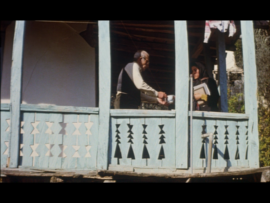
The director in the film adopts this view when he responds to Rouhi’s attempt at deconstruction: “But this house has survived, that’s also a truth.” Yes, Rouhi agrees, the film is a truth, it doesn’t lie, after which we see him stumble about looking for a bowl to give Puya some water to drink in a house that is clearly not his and how he has to be helped by a woman who appears to be the film’s script girl (we hear Kiarostami’s voice in the background asking her for the bowl). With this scene we have entered the realm of Godardian pastiche that will only become more prominent when Kiarostami next makes a film about the shooting of a film, Through the Olive Trees, thus joining the eminent ranks of Godard, Fellini, Minnelli, Fassbinder and Truffaut.
Godard famously accused the latter’s La Nuit américaine (1973), in which Jean-Pierre Léaud plays a thinly veiled version of Truffaut who has an affair with Jacqueline Bisset, Truffaut’s real-life lover at the time, of being a lie. You are a liar, Godard wrote in a letter to his friend, “because the shot of you and Jacqueline Bisset the other night at Chez Francis is not in your film, and one wonders why the director is the only one who doesn’t fuck in La Nuit américaine.” Kiarostami’s film plays like a comment on that comment by making a film about the making of a film that actually exists, but turning everything into a blatant lie from the start. The film opens with a direct address to the camera by an actor introducing himself as (theatre and film actor) Mohamad A. Keshavarz, who will play the role of the director of Where is the Friend’s Home? this time around. In a documentary, specifically reportage or ‘cinema verité’, such breaking of the fourth wall is common to the point of conventionality. Since the person addressing the camera talks about the role he is going to play, the logical assumption is that what follows will be a documentary registration of a performance, of a play, in the manner of Louis Malle’s Vanya on 42nd Street (1994). Although the film never returns to the direct address, isolating it in the prologue, and finally reveals itself as a fiction with characters (although with a documentary basis: the filming of Life, and Nothing More…), I would nevertheless like to keep the theatrical association. Less a Brechtian alienation device than a return to Shakespearian conventions, the opening presents the director as a kind of Senex figure who, in this incarnation, does not hinder the young lovers’ union but facilitates it, making explicit the story’s basis in Shakespearian romance, the tragedy that ends happily. Kiarostami had originally conceived of the story of Hossein and Tahereh as a harsh social critique of Iranian traditionalism, of strict social mores remaining unshaken even after a cataclysm, and had not intended the film-about-film structure. But it was probably because he was thinking about a ‘Romeo and Juliet’ story (or ‘Layla and Majnun,’ or, more aptly, ‘Khosrow and Shirin,’ in the Persian tradition) set in Koker, that the romance-like structure, including a play within the play and a fairytale happy ending (All’s Well That Ends Well), imposed itself.
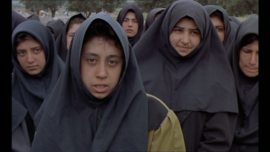
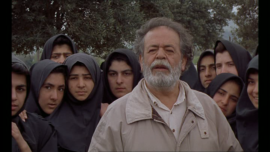
As Kiarostami tells it, the idea for Olive Trees came to him when he noticed a romantic attraction between two local actors during the shooting of Life, and Nothing More…: Hossein Rezai (another sad-eyed idealist with Turkish roots), who played a young man who got married the day after the earthquake, seemed to have real feelings for the girl who played his young bride, a middle-class girl who had lost her parents in the quake. The girl remained nameless in the film. In Olive Trees she is called Tahereh (played by Tahereh Ladanian), but there is no reason to assume that this is the girl who aroused Hossein’s feelings in real life (the young wife was played by another actress in Life…), or even that Hossein is necessarily playing ‘himself.’ For one, his occupation of construction worker and bricklayer seems too allegorically neat for a story in which the social barrier that is at the story’s center is upheld by the girl’s grandmother precisely on the basis that Hossein is not just illiterate but has no house of his own. Moreover, in the film’s prologue we see how Tahereh is cast in the role during a session that is itself a lie given that it intercuts staged footage of Keshavarz surrounded by young veiled girls with much rawer, much more ‘realistic’ handheld material possibly deriving from Kiarostami’s original casting interviews.
So, as in Close-Up and Life…, the distinction between real-life person and character is blurred, or rather, what interests Kiarostami is how reality and fiction can be seen to run in parallel. Such parallelism or convergence, rather than the more deconstructionist meaning of mise-en-abîme as endless loop, becomes, naturally, more complicated as films around the same subject and characters multiply. In the prologue the director claims that, himself excepted, all the actors for the film were cast on the spot. If the film the director is talking about is indeed Life, and Nothing More… this is incorrect, if not a lie, as both Farhad Keradmand (who appears in the film) and Puya Bayour (who is only heard offscreen) were cast in Teheran. But can we be sure that the film that is being shot in Olive Trees is really Life and Nothing More…? Remember the idea of parallel paths: Kiarostami’s intent is not to show how two actors fell in love during his shoot – how can he? – but to make a film about that situation, a re-enactment that emphasizes the Shakespearian overtones of the original. A strange splitting off seems to occur with the earlier film producing a phantom double that produces two strikingly odd moments in the film. The first happens when Madame Shiva, the production manager, encounters the Ahmadpour boys on their way to school. This is some coup: the boys that were never found in the previous film, now casually run into the frame provided by her rearview mirror, further proof that Life… never really hinged on them and that the film was mistakenly taken to be some kind of thriller. But although Madame Shiva did recognize an earlier passer-by as the man who played the schoolmaster in Where is the Friend’s Home?, she fails to recognize the Ahmadpour boys, despite the fact that the film she is working on is supposedly about them. Of course, how can she recognize the boys, who are now strapping teens while in the timeframe of the film (and the film-in-the-film) they are no older than ten. Moreover, we must remember that the Ahmadpours never appear in Life…. But still the failure to place them is odd. And talking about confusing timelines, the first words we hear in the film after the casting prologue, are said by a radio announcer who gives us the date, 30 May 1993, the actual day of shooting, or, almost three years after the earthquake and two years after the real Life… was shot. Another, even more blatant instance of doubling occurs when, in a flashback (a rare exception in Kiarostami’s films after Close-Up), in which Hossein is seen trailing Tahereh’s grandmother once again asking for her ward’s hand, and ends up disturbing the shooting of a scene from Life, and Nothing More…, not the film that is being shot in Through the Olive Trees, but a shoot in the past, with Kiarostami and not Keshavarz clearly visible as the director calling the shots.
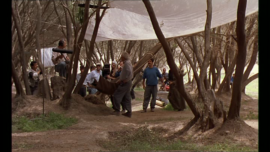
Is there no end to these cinematic games? And why doesn’t such ‘mise-en-abîme’ deserve to be identified as such, deserve to be called postmodern? In the Bomb interview Kiarostami prefers to talks about ‘layers of truth’:
My own son was critical of me because in the second film, Life Goes On [an alternative title for Life, and Nothing More…], I hint that these two people are married, and that’s what I lead the audience to believe at the end of that film. In Through the Olive Trees, I come up with the idea that they are not really married, and it’s just the boy who is really fascinated by the girl. In my next film, I’m going to show another layer of truth in that actually the boy is not really that crazy about the girl. So, my son is critical that I keep lying to people, that I keep changing. In the next film it’s really the girl who loves the boy.
That third film, to be given the Shakespearian title Tahereh’s Dreams, never happened despite eighteen months of preparation, but it’s clear that Kiarostami is still thinking in terms of the variations of Orderly or Disorderly. Neither version of the Hossein-Tahereh love story is necessarily ‘true’; the ‘real’ Hossein and Tahereh are local (non-)actors playing out different facets and possibilities of the same story, just as Kiarostami shows us both sides, both behind and in front of the camera. The permutational structure is central to the film and inherent in the filming process that proceeds in different takes of the same shot, separated by claps. So, amidst this endless mediation and reflecting, where does this truth actually reside? Where does the truth lie? In Life… it was in moments of beauty, a beauty constructed for sure, but a beauty nonetheless that allowed us to see the truth of Koker’s endurance and sense of community. The same thing can be said about Olive Trees: the truth is that when Tahereh sets off with her potted geraniums in the famous ending of the film, with Hossein in hot pursuit juggling a thermos and a blue bucket full of jangling teacups, navigating through the olive trees as with the grandmother before but now properly in their own film, up the zigzag path of Where is the Friend’s Home?, helicopter sounds re-appearing and tying the moment to Life…’s existentialist finale, past the solitary tree at the top, all ‘constructed’ by Kiarostami, heading into a ‘cosmic’ long shot of a beautiful grove – a ‘Garden’ scene set to baroque music by Cimarosa – it is clear that imagination, beauty and cinema have won out again over reality and (repressive) convention. As Hossein skips through the fields, returning from his pastoral encounter like a bucolic shepherd, the camera stays at a respectful distance with Keshavarz’s Senex figure watching through the olive trees. Their true intimacy is none of our business. That is also a truth.
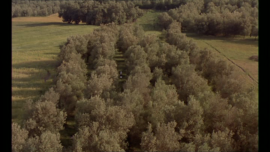
And what about the trap that Godard thought Truffaut laid for himself by romanticizing the role of the director? Well, for one, this is not the director’s film: there are at least four perspectives in the story, and you would be hard-pressed to find he most important one: is it Hossein’s, Tahereh’s, the director’s, or Madame Shiva’s? And what about Kiarostami’s perspective? The tenderest look, let’s say regard, the film casts is not on Hossein or Tahereh, but on another, ‘secondary’ character, the camp’s middle-aged cook who lost his wife in the earthquake and can still enjoy a good meal and a hearty laugh. Moreover, if the director is the one who demands respect for Hossein and facilitates the romance, he is also the arrogant intruder who shapes a found reality according to his own aesthetic or political agenda, a theme that Kiarostami will further develop in The Wind Will Carry Us, in which a film crew invades a Kurdish village in the hope to film an ancient funerary rite, setting up Kiarostami’s most blatant auto-critique. The scene in the film-in-the-film in which Hossein tells the director (Keshavarz) about the number of relatives he lost – a mind-blowing moment in Life… – he is interrupted by a severe, “Cut!,” and corrected with authority: “It’s 65.” “But I only lost 25!” a confused Hossein replies. “It’s 65.” It might look like it was all made up on the spot, Kiarostami seems to be saying, but everything was laid down in advance.
Here’s another statement from the Bomb interview:
Our work starts with a lie on a daily-routine basis. When you make a film you bring elements from other places, other environments, and you gather them together in a unity that really doesn’t exist. You’re faking that unity. You call someone a husband or a son …
At least four preliminary insights can be derived from this: 1) fiction begins with the creation of a character (“You call someone a husband or a son,” or a carpenter, or a director); 2) cinema has a reality of its own and therefore “anything that can happen would be true” 3) the fact that cinema is not ‘real’ reality but, so to say, ‘runs parallel to it,’ makes it a vehicle for truth 4) the original ‘lie’ of cinema is that it creates a unity between disparate elements, in other words that it is a medium of montage. The first has already been illustrated by the case of Mr. Rouhi and by Kiarostami’s comments on the continuing adventures of Hossein and Tahereh. The second is evident in a way we will come back to in the second part of this essay. The third we will also hold in abeyance, while the fourth directs us towards one of the most understudied aspects of Kiarostami’s style. Although he has often been quite ludicrously lopped together with ‘slow cinema’ practitioners favoring the uninterrupted long take, Kiarostami is essentially a Kuleshovian. His experimental film Shirin (2008), in which the viewer is invited to construct an unseen film from the reaction shots of the all-female audience, is perhaps the best illustration of the principle, only this time instead of the object of perception determining our reading of the perceiver’s gaze as in Kuleshov’s famous experiment (Mozhukin + soup equals ‘hungry,’ a concept in itself unrepresentable), it is the gaze that shapes the object of perception (Mehrnaz Saeed-Vafa detects in Shirin a Hitcockian dimension: “For me, the way he’s like Hitchcock is the way he looks at women who are reflecting horrors that we don’t see, with a lot of intensity.” Hitchcock, of course, was a Kuleshovian). In the latest issue of Cahiers du cinema, Kiarostami’s friend and colleague Amir Naderi reflects on the centrality of montage to their art and remembers how he went to the Russian embassy in Teheran to study films by Eisenstein, Vertov, Dovzhenko. Like these Russian predecessors Kiarostami is as concerned with what is in the shot as what is produced through the combination of shots. Montage allows for what Perez takes to be Kiarostami’s “gift for embodying thought, grounding the conceptual in the material and investing the material with the conceptual … He successfully combines the documentary nature of film with its symbolic, evocative, ruminative capabilities.” Kiarostami’s greatest cinematic inspiration, Robert Bresson, was also convinced that the importance of the image is in its relationship to what comes before and after. As he writes in Notes on the Cinematograph: “To create is not to deform or invent persons and things. It is to tie new relationships between persons and things which are, and as they are … Bring together things that have as yet never been brought together and did not seem predisposed to be so.” This is manipulation, for sure, but always in function of achieving truth: to recreate in order to see what something really is, to see again in order to genuinely look at it.
Kiarostami the obfuscator
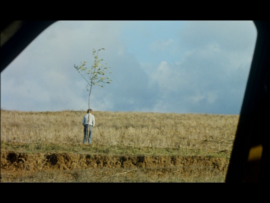

Kiarostami’s is an art of the observer, both from the point of view of the narration and within the story world. Most of the films between Close-Up and Ten (2002) feature filmmakers as characters, and those that aren’t filmmakers, like Mr. Badii in Taste of Cherry, spend most of the running time doing what filmmakers do: looking closely, paying attention, scanning the world. The result of all this looking is not just the observation that a look speaks volumes (as in the single sad, longing look that Tahereh gives Hossein) or a thematization of the filmmaker’s ‘gaze’ and its intrusive or disruptive aspects, but also a part ethical-part formalist reflection on how looking and the object of that look can be edited together to constitute the unity of the fictional world regardless of whether observer and observed were ever at the same place at the same time. The centrality of editing to Life, and Nothing More… is probably what led Godard to coin his much-cited epigraph: “The cinema starts with Griffith and ends with Kiarostami.” There’s a beautiful moment early on in Life… when Puya gets out of the car to pee, finding droll cover behind a sapling tree, that starts a series of eyeline matches of the director taking in the environment (Puya does his own observing from the backseat, leading to exquisitely framed shots of the rocky, mountainous landscape).
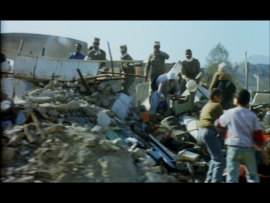
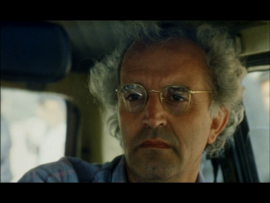
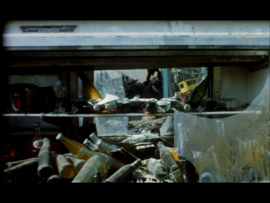
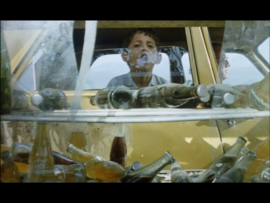
The eyeline match will become even more prominent a feature in the film as director and son have passed through the long dark tunnel that marks the beginning of their journey of initiation and Kiarostami shows us the destruction around Rudbar through the director’s eyes, ‘documentary’ shots that were clearly taken at an earlier time and from one side only, the passenger’s side. One iconic shot is of a shattered soda cooler in which the coke bottles are still intact. When Puya asks his dad to back-up the car because he wants to get one of those bottles, Kiarostami gives us a 180° reverse shot, a perspective through the cooler (anticipating the famous shaving mirror trick in The Wind Will Carry Us), that now with its reordered bottles takes on the eerie quality of a still life, a nature morte.
Another aspect we have to note is that for the first ten minutes of the film, there are only two shots with the father and son in the same shot and in these shots they are not conversing. The dialogue sequences mostly consist of reverse-angle singles, lack an establishing two-shot and leave in doubt whether the two actors ever actually exchanged dialogue. This hints at what we already know: that Kiarostami served as interlocutor in these sequences so as to be able to coach the non-professional actors as they were being filmed (again much in the way of Griffith). This approach, that doubles as an ethical imperative to announce the maker’s ‘presence’ in the fiction, has been amply discussed in relation to Taste of Cherry and The Wind Will Carry Us, but the practice originated much earlier, arguably with the reverse shots of the filmmakers in Homework that were taken in Kiarostami’s home and inserted into the film as a kind of punctuation at the very last moment. The idea of close-ups being recorded separately from the master shot registering the action was, of course, standard Hollywood practice. There are several illustrious examples – from Bogart’s famous nod in Casablanca (1942), shot weeks after the rest of the Marseillaise scene, to Frank Capra having discs made of a scene’s soundtrack to get an actor back into the mood of the scene when it was time to take the close-ups or reaction shots. The difference here is that there is nary a trace of a master shot in which we see the principals interacting. The technical or craft problems involved in matching these shots which in Bresson’s parlance “were not predisposed to each other,” is awe-inspiring, especially in the sound-mix (taking away one voice, Kiarostami’s, and putting in another, the actor’s while maintaining continuity in the atmospheric background noise) which is of a sophistication and complexity to match Bresson. This integral part of Kiarostami’s craft is radically denied, together with the filmmaker’s presence, in Ten (2002), in which two small digital cameras were mounted on the dashboard, while the director fed the actor lines of dialogue through an earpiece from the backseat, sitting in the exact blind spot left by the crossed sightlines of the cameras.
The Wind Will Carry Us provides another variation on Kiarostami’s handling of shot-reverse shot by withholding or obfuscating the reverse angle: several characters that play an important part in the fiction are not visible in the film, most notably the film crew, the pregnant neighbor across the court, the man digging the ditch and the old woman who is dying. The missing reverse shot actually becomes the theme of Shirin, as the viewer must construct the movie the women are watching from the soundtrack and their reaction shots. This tendency toward subtraction is confirmed by the minute of total darkness at the end of Taste of Cherry, an obscuring repeated in the documentary Kiarostami made for the United Nations on the orphan problem in Uganda, ABC Africa (2002): when the electricity goes, the film crew is left in the dark and the film becomes radio. But the will to obfuscate was already there in the ‘blocked’ or withheld views in Life… and Olive Trees: in the wipe-by cuts at the beginning of Life… or all those obscured views ‘through the olive trees’; in the fact that we never get a proper look at the woman in the traffic jam to whom Puya gives the last of his coke for her crying baby, at Mr. Rouhi, or the schoolteacher, or the interlocutors in Taste of Cherry before they get in the car with Mr. Badii. And of course the subtractive aesthetic is there in the episodic structure and narrative ellipsis: in the delaying of story information concerning the character’s identity and goals, in rendering motivation and characterization opaque (why does Mr. Badii want to kill himself? Who is he anyway?) and the lack of clear dénouement, the famous open endings (does he finally kill himself? Are the Ahmadpour boys ever found?), already essayed in The Traveller, in which we never get to watch the football game. Philosopher Alain Badiou has framed these ellipses – part and parcel of the modernist aesthetic – in ontological terms when he says that in Kiarostami “the absent is part of the image’s presence” (a logic reminiscent of Sartre’s observation – borrowed from Heidegger – that absence has a presence, as when a friend we were expecting fails to show up). Kiarostami calls it “being without being”, which he believes is the main theme of The Wind will Carry Us:
With this type of movie, we as viewers can create things according to our own experiences-the things we don’t see, that aren’t visible. There are 11 people in this movie who are not visible. At the end you know you haven’t seen them, but you feel you know who they were and what they were about. I want to create the type of cinema that shows by not showing. This is very different from most movies nowadays, which are not literally pornographic but are in essence pornographic, because they show so much that they take away any possibility of imagining things for ourselves. My aim is to give the chance to create as much as possible in our minds, through creativity and imagination. I want to tap the hidden information that’s within yourself and that you probably didn’t even know existed inside you. We have a saying in Persian, when somebody is looking at something with real intensity: “He had two eyes and he borrowed two more.” Those two borrowed eyes are what I want to capture-the eyes that will be borrowed by the viewer to see what’s outside the scene he’s looking at. To see what is there and also what is not there.
When he calls on the audience to complete the film through their imagination, he seems to be putting a humanist spin on the Eisensteinian constructivist principle that meaning is finally created by the viewer’s active participation in conceptualizing or ‘imaging’ what is in the combination of shots. From a literary-theoretical perspective, Umberto Eco, in his classic The Open Work, distinguishes between two kinds of ‘openness’: the author presents a finished work that he wants to be appreciated and received in the same form as he devised it, while still allowing the individual addressee to supply his own ‘existential credentials,’ his own set of tastes, cultural prejudices and inclinations etc. This insures that the work, although reconstituted in its original form, gains in aesthetic validity because of the different perspectives that are offered on it. The truly open work, however, is one where the work does not present itself as finished and invites the addressee to be a co-creator. A different work therefore is created every time it is experienced by an audience. Eco associates the latter with aleatory music. Kiarostami’s films seem to occupy a terrain between these two possibilities. Kiarostami comes close to Eco’s first option when he says that “When you see a film, you should come away with your own personal interpretation, based on who you are. The film should allow that to happen, make room for that interaction.” In its closeness to poetry, allegory and serialism, on the other hand, the work also seems to fit the latter category. At the same time Kiarostami’s films are not as open as, say, those of Alain Robbe-Grillet. What they resemble most, in the end, is an openness you could define as ‘ethical’ that harks back to Bazin’s essay on ‘William Wyler, or the Jansenist of Directing’ (1948). With a reductive, simplified form, in which the “mise en scène seems to define itself through its absence,” the audience “becomes free to create its own mise en scène,” Bazin writes, fully in mind of Sartre’s What is Literature? published the same year, that stressed the reader’s ‘engaged’ freedom. Bazin – and Rivette and Rohmer after him – liked the term ‘mystery’ for an image that is left uncompleted, that is left to the viewer’s imagination. There are many aspects to this mystery but one is precisely ontological: Heidegger wrote about the primary importance of ‘work’ in the term ‘artwork.’ When the object is put before us so completely that the content is exhausted, interest ceases. Interest only arises where there is necessary activity of the mind, when there is something secret, un-revealed. Heidegger refers in this context of revealing and unrevealing to the ‘riddle’ that art is.
